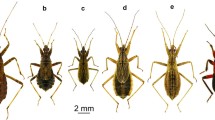Summary
The electrophysiological responses of the maxillary gustatory sensilla of ten species of lepidopterous larvae to sugars, polyhydric alcohols, amino acids, organic acids, glycosides, and sterols were tested. Of the caterpillars examined three were monophagous (Calpodes ethlius, Ceratomia catalpae, Danaus plexippus), three were oligophagous (Pieris rapae, Papilio polyxenes, Malacosoma americana), and four were polyphagous (Helioihis zea, Estigmene acrea, Isia isabella, Porthetria dispar). The sensilla of all species are structurally similar to the extent of having four chemosensory bipolar neurons in each peg.
It is not possible to account for the wide range of responsiveness to diverse compounds in terms of narrowly specific receptors characterized as water, sugar, salt, inositol, or amino acid receptors. Bach receptive cell was found to have only a limited degree of specificity. Not all amino acids stimulated the same cell. Some amino acids stimulated only one; some stimulated two; some inhibited all cells; some inhibited one while stimulating another. Differential sensitivity to amino acids varied from species to species and even between the two sensilla in an individual.
The diversity of relationships found with amino acids existed also with respect to acids and glycosides. Ascorbic and hydrochloric acids at equivalent pH values each stimulated a different cell. Glycosides stimulated one or two cells depending on the species and sensillum.
Synergism occurred nearly as often as inhibition. Among the instances were synergistic reactions between sucrose and inositol, proline and inositol, sucrose and sinigrin, glycine and sucrose. The occurrence of the phenomenon was specific to certain species and sensilla.
Results point to the conclusion that the basis of difference in sensitivity to different compounds from species to species and from receptor to receptor reflects variations in the molecular structure of the receptor substrate. Whatever the mechanisms involved it is clear that caterpillars are able to detect not only compounds that may be of nutritive value but also non-nutritive compounds some of which are secondary plant substances. When the total taste sensitivities of the various species of caterpillars are compared, there is no obvious difference between polyphagous, oligophagous, and monophagous species.
Similar content being viewed by others
References
Beidler, L. M.: Taste receptor stimulation. In: Progress in biophysics and biophysical chemistry, p. 107–151. Oxford: Pergamon Press 1961.
Colowick, S. P., Kaplan, N. O.: Methods in enzymology, vol. I, p. 143. New York and London: Academic Press 1955.
Dethier, V. G.: Gustation and olfaction in lepidopterous larvae. Biol. Bull. 72, 7–23 (1937).
Ishikawa, S.: Responses of maxillary receptors in the larva of the silkworm, Bombyx mori, to stimulation by carbohydrates. J. cell. comp. Physiol. 61, 99–107 (1963).
—: Electrical response and function of a bitter substance receptor associated with the maxillary sensilla of the larva of the silkworm, Bombyx mori L. J. cell. Physiol. 67, 1–12 (1966).
—, Hirao, T., Arai, N.: Chemosensory basis of hostplant selection in the silkworm. Ent. Exp. Appl. 12, 544–554 (1969).
Morita, H.: Initiation of spike potentials in contact chemosensory hairs of insects. III. D. C. stimulation and generator potential of labellar chemoreceptors of Calliphora. J. cell. comp. Physiol. 54, 189–204 (1959).
—, Hidaka, T., Shiraishi, A.: Excitatory and inhibitory effects of salts on the sugar receptor of the fleshfly. Mem. Fac. Sci., Kyushu Univ., Series E 4, 123–135 (1966).
—, Shiraishi, A.: Stimulation of the labellar sugar receptor of the fleshfly by monoand disaccharides. J. gen. Physiol. 52, 559–583 (1968).
Mosher, F. H.: Food plants of the gypsy moth in America. U. S. Dept. Agric. Bull. 250, 1–39 (1915).
Omand, E., Dethier, V. G.: An electrophysiological analysis of the action of carbohydrates on the sugar receptor of the blowfly. Proc. nat. Acad. Sci. (Wash.) 62, 136–143 (1969).
Peterson, A.: Larvae of Insects. Part I. Lepidoptera and hymenoptera. Ann Arbor, Mich.: Edwards Bros. Inc. 1948.
Schoonhoven, L. M.: Chemoreception of mustard oil glucosides in larvae of Pieris brassicae. Koninkl. Nederl. Akad. Wetensehappen, Amsterdam. Series C, 70, 556–568 (1967).
—: Chemosensory bases of host plant selection. Ann. Rev. Ent. 13, 115–136 (1968).
—: Amino-acid receptor in larvae of Pieris brassicae (Lepidoptera). Nature (Lond.) 121, 1268 (1969a).
—: Gustation and foodplant selection in some lepidopterous larvae. Ent. Exp. Appl. 12, 555–564 (1969b).
—, Dethier, V. G.: Sensory aspects of host-plant discrimination by lepidopterous larvae. Arch. Neerl. Zool. 16, 497–530 (1966).
Shiraishi, A., Kuwabara, M.: The effects of amino acids on the labellar hair chemosensory cells of the fly. J. gen. Physiol. 56, 768–782 (1970).
Takeda, K.: The nature of impulses of single tarsal chemoreceptors in the butterfly, Vanessa indica. J. cell. comp. Physiol. 58, 233–245 (1961).
Thorsteinson, A. J.: Host selection in phytophagous insects. Ann. Rev. Ent. 5, 193–218 (1960).
Waldbauer, G. P., Fraenkel, G.: Feeding on normally rejected plants by maxillectomized larvae of the tobacco hornworm, Protoparce sexta (Lepidoptera, Sphingidae). Ann. Ent. Soc. Amer. 54, 477–485 (1961).
Wolbarsht, M. L.: Electrical activity in the chemoreceptors of the blowfly. II. Responses to electrical stimulation. J. gen. Physiol. 42, 413–428 (1958).
Author information
Authors and Affiliations
Additional information
This work was supported by National Science Foundation Grant GB 1472.
Rights and permissions
About this article
Cite this article
Dethier, V.G., Kuch, J.H. Electrophysiological studies of gustation in lepidopterous larvae. Z. vergl. Physiologie 72, 343–363 (1971). https://doi.org/10.1007/BF00300708
Received:
Issue Date:
DOI: https://doi.org/10.1007/BF00300708




